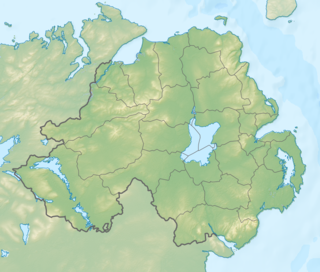Related Research Articles

The East Tyrone Brigade of the Provisional Irish Republican Army (IRA), also known as the Tyrone/Monaghan Brigade was one of the most active republican paramilitary groups in Northern Ireland during "the Troubles". It is believed to have drawn its membership from across the eastern side of County Tyrone as well as north County Monaghan and south County Londonderry.
Pádraig Oliver McKearney was a Provisional Irish Republican Army (IRA) paramilitary. He was killed during a British Army ambush at Loughgall, County Armagh in May 1987, aged 32.
The Troubles in Crossmaglen recounts incidents during, and the effects of, the Troubles in Crossmaglen, County Armagh, Northern Ireland.
The Troubles in Dungannon recounts incidents during, and the effects of, The Troubles in Dungannon, County Tyrone, Northern Ireland.
The Troubles in Killeen recounts incidents during, and the effects of, The Troubles in and around the village of Killeen, County Armagh, Northern Ireland.
The Troubles in Forkhill recounts incidents during, and the effects of, the Troubles in Forkhill, County Armagh, Northern Ireland.
The Troubles in Cookstown recounts incidents during, and the effects of, The Troubles in Cookstown, County Tyrone, Northern Ireland.
The Troubles in Keady refers to incidents taking place in Keady, County Armagh, Northern Ireland during the Troubles.
The Troubles in Bessbrook recounts incidents during and the effects of the Troubles in Bessbrook, County Armagh, Northern Ireland.
The Troubles in Lurgan recounts incidents during the Troubles in Lurgan, County Armagh, Northern Ireland.
On 7 December 1985 the Provisional Irish Republican Army (IRA) attacked the Royal Ulster Constabulary (RUC) base at Ballygawley, County Tyrone. Two RUC officers were shot dead and the base was raked with gunfire before being completely destroyed by a bomb, which wounded a further three officers.

The 6th Battalion, Ulster Defence Regiment was formed in 1970 as part of the seven original battalions specified in The Ulster Defence Regiment Act 1969, which received Royal Assent on 18 December 1969 and was brought into force on 1 January 1970. It was, along with the rest of the regiment, amalgamated with the Royal Irish Rangers in 1992 to form the Royal Irish Regiment.

The Ballygawley bus bombing was a roadside bomb attack by the Provisional Irish Republican Army (IRA) on a bus carrying British soldiers in Northern Ireland. It occurred in the early hours of 20 August 1988 in the townland of Curr near Ballygawley, County Tyrone. The attack killed eight soldiers and wounded another 28. In the wake of the bombing, the British Army began ferrying its troops in and out of County Tyrone by helicopter.

The Ballygawley land mine attack was a bomb attack carried out by the Provisional Irish Republican Army (IRA) on the 13 July 1983. The IRA exploded a landmine under an Ulster Defense Regiment's (UDR) mobile patrol at Ballygawley Road, near Dungannon in County Tyrone, Northern Ireland. Four UDR soldiers were killed in the incident.

The Bessbrook bombing took place on the 17 April 1979 when four Royal Ulster Constabulary (RUC) officers who were travelling in a RUC Land Rover were killed when the Provisional IRA detonated via remote-control an estimated 800 - 1,000 pound roadside van bomb on Milvale Road just outside Bessbrook, County Armagh, believed to be the largest bomb used by the IRA up to that point.

On 9 April 1990 the Provisional IRA (IRA) detonated a massive IED roadside bomb under an Ulster Defence Regiment (UDR) mobile patrol which killed four members of the UDR. It was the worst attack against the UDR since seven years previously when, in July 1983, four soldiers of the same regiment were killed in a similar attack near Ballygawley. It was also one of the worst attacks against the security forces in County Down since the Warrenpoint Ambush of August 1979 when 18 British soldiers were killed and six injured.

The Attack on RUC Birches barracks was an attack on 11 August 1986, the East Tyrone Brigade of the Provisional Irish Republican Army (IRA) attacked the Royal Ulster Constabulary (RUC) base at The Birches near Portadown, in North Armagh Northern Ireland. The unmanned base was first raked with gunfire before being completely destroyed by a 200 pounds (91 kg) bomb, which was driven through the gate of the base in the bucket of a JCB digger.

The Killeen Landmine attack took place on the 20 May 1985 when four Royal Ulster Constabulary (RUC) officers were killed when the Provisional IRA exploded an estimated 1,000 pound roadside bomb hidden in a trailer at Killean, County Armagh. The attack occurred just three months after nine RUC officers were killed and 37 injured in the 1985 Newry mortar attack.

On 21 December 1978, three British soldiers were shot dead when the Provisional IRA's South Armagh Brigade ambushed an eight-man British Army foot patrol in Crossmaglen, County Armagh, Northern Ireland.

The Dungannon land mine attack was an Improvised explosive device attack and shooting against a British Army mobile patrol. The attack was carried out by IRA volunteers from the Provisional IRA's East Tyrone Brigade on 16 December 1979, along the Ballygawley Road, just outside Dungannon in County Tyrone. Four British soldiers who were on mobile patrol were killed in the ambush.
References
- ↑ Malcolm Sutton. http://cain.ulst.ac.uk/sutton/chron/1975.html
- ↑ "Chronological list of deaths, 1983". Conflict Archive on the Internet (CAIN). Retrieved 11 August 2010.
- ↑ "Chronological list of deaths, 1985". Conflict Archive on the Internet (CAIN). Retrieved 11 August 2010.
- ↑ "Chronological list of deaths, 1988". Conflict Archive on the Internet (CAIN). Retrieved 11 August 2010.